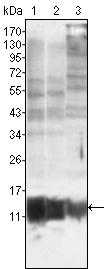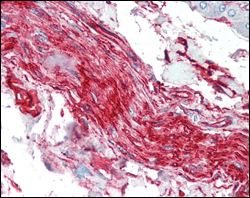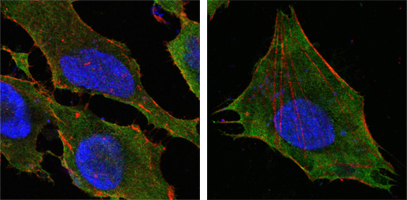S-100A10 Monoclonal Antibody
- Catalog No.:YM0573
- Applications:WB;IHC;IF;ELISA
- Reactivity:Human
- Target:
- S-100A10
- Fields:
- >>Salmonella infection
- Gene Name:
- S100A10
- Protein Name:
- Protein S100-A10
- Human Gene Id:
- 6281
- Human Swiss Prot No:
- P60903
- Mouse Swiss Prot No:
- P08207
- Immunogen:
- Purified recombinant fragment of human S-100A10 expressed in E. Coli.
- Specificity:
- S-100A10 Monoclonal Antibody detects endogenous levels of S-100A10 protein.
- Formulation:
- Liquid in PBS containing 50% glycerol, 0.5% BSA and 0.02% sodium azide.
- Source:
- Monoclonal, Mouse
- Dilution:
- WB 1:500 - 1:2000. IHC 1:200 - 1:1000. IF 1:200 - 1:1000. ELISA: 1:10000. Not yet tested in other applications.
- Purification:
- Affinity purification
- Storage Stability:
- -15°C to -25°C/1 year(Do not lower than -25°C)
- Other Name:
- S100A10;ANX2LG;CAL1L;CLP11;Protein S100-A10;Calpactin I light chain;Calpactin-1 light chain;Cellular ligand of annexin II;S100 calcium-binding protein A10;p10 protein;p11
- Molecular Weight(Da):
- 11kD
- References:
- 1. Svenningsson P, Greengard P. Curr Opin Pharmacol. 2007;7(1):27-32.
2. Santamaria-Kisiel L, Rintala-Dempsey AC, Shaw GS. Biochem J. 2006;396(2):201-14.
3. Rust R, VL, van dJ, Harms G,.et al.
- Background:
- The protein encoded by this gene is a member of the S100 family of proteins containing 2 EF-hand calcium-binding motifs. S100 proteins are localized in the cytoplasm and/or nucleus of a wide range of cells, and involved in the regulation of a number of cellular processes such as cell cycle progression and differentiation. S100 genes include at least 13 members which are located as a cluster on chromosome 1q21. This protein may function in exocytosis and endocytosis. [provided by RefSeq, Jul 2008],
- Function:
- function:Because S100A10 induces the dimerization of ANXA2/p36, it may function as a regulator of protein phosphorylation in that the ANXA2 monomer is the preferred target (in vitro) of tyrosine-specific kinase.,miscellaneous:Does not appear to bind calcium. Contains 2 ancestral calcium site related to EF-hand domains that have lost their ability to bind calcium.,similarity:Belongs to the S-100 family.,subunit:Heterotetramer containing 2 light chains of S100A10/p11 and 2 heavy chains of ANXA2/p36. Interacts with SCN10A.,
- Subcellular Location:
- integral component of membrane,extrinsic component of plasma membrane,membrane raft,extracellular exosome,
- Expression:
- Brain,Keratinocyte,
- June 19-2018
- WESTERN IMMUNOBLOTTING PROTOCOL
- June 19-2018
- IMMUNOHISTOCHEMISTRY-PARAFFIN PROTOCOL
- June 19-2018
- IMMUNOFLUORESCENCE PROTOCOL
- September 08-2020
- FLOW-CYTOMEYRT-PROTOCOL
- May 20-2022
- Cell-Based ELISA│解您多样本WB检测之困扰
- July 13-2018
- CELL-BASED-ELISA-PROTOCOL-FOR-ACETYL-PROTEIN
- July 13-2018
- CELL-BASED-ELISA-PROTOCOL-FOR-PHOSPHO-PROTEIN
- July 13-2018
- Antibody-FAQs
- Products Images

- Western Blot analysis using S-100A10 Monoclonal Antibody against MCF-7 (1), HepG2 (2) and HeLa (3).

- Immunohistochemistry analysis of paraffin-embedded human nerve and ganglion cells with AEC staining using S-100A10 Monoclonal Antibody.

- Confocal immunofluorescence analysis of Hela (left) and L-02 (right) cells using S-100A10 Monoclonal Antibody (green). Red: Actin filaments have been labeled with DY-554 phalloidin. Blue: DRAQ5 fluorescent DNA dye.


